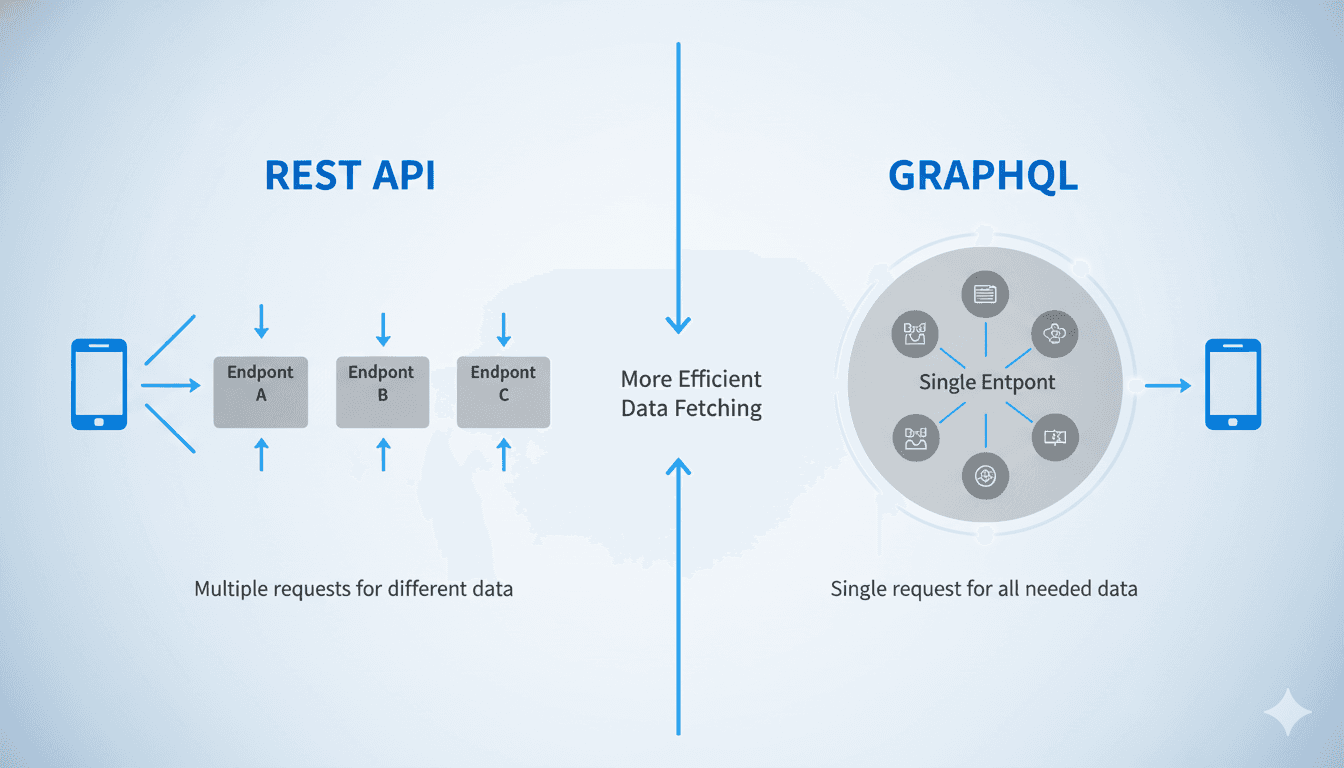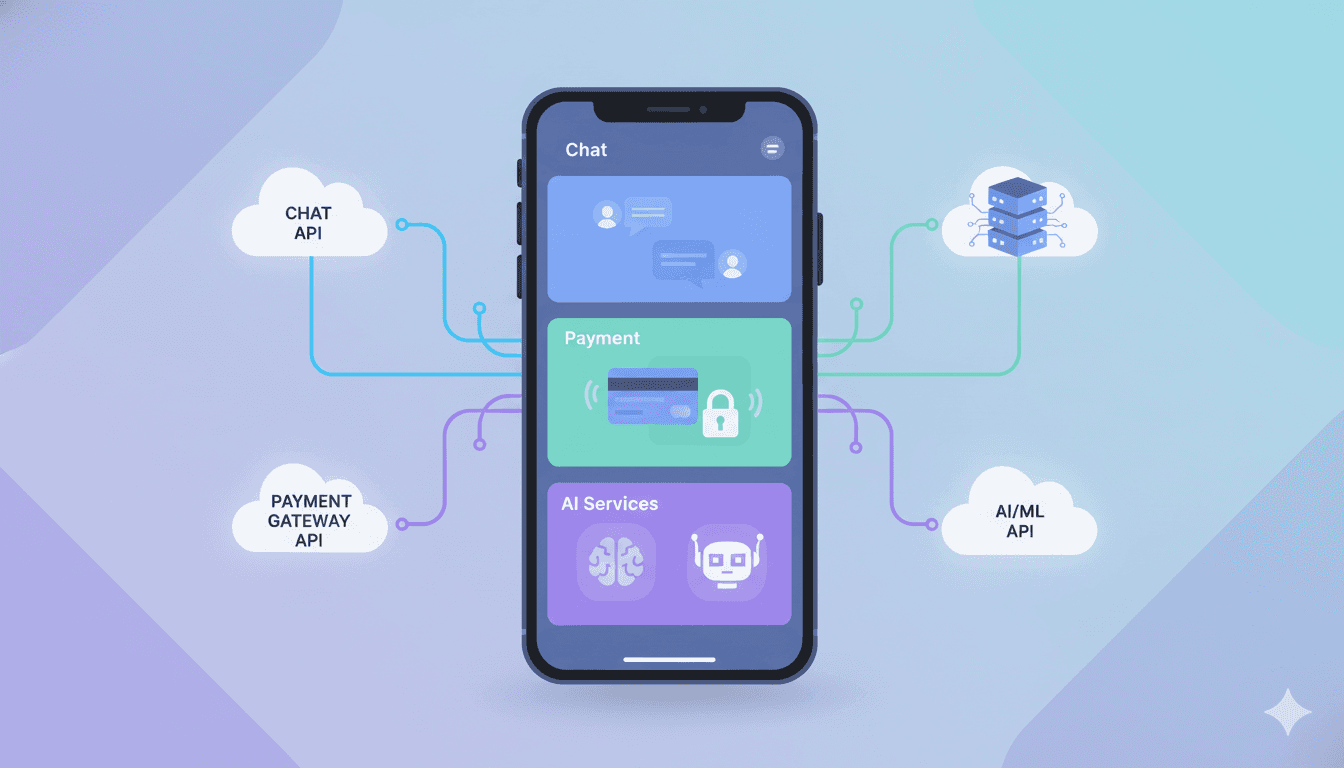In today's interconnected digital ecosystem, Application Programming Interfaces (APIs) serve as the invisible backbone that powers virtually every modern application and service we use. Whether you're checking the weather on your smartphone, making an online payment, or sharing content on social media, APIs are working behind the scenes to make these interactions seamless and efficient.

What is an API? (Application Programming Interface)

What is an API?
An API, or Application Programming Interface, is a set of protocols, tools, and definitions that allows different software applications to communicate with each other. Think of an API as a waiter in a restaurant: you (the client) give your order to the waiter, who takes it to the kitchen (the server), and then brings back your food (the response). The waiter acts as an intermediary, just like an API does between different software systems.
APIs define the methods and data formats that applications can use to request and exchange information. They abstract the complexity of underlying implementations, allowing developers to leverage existing functionality without needing to understand how it works internally. This standardization enables software integration, promotes reusability, and accelerates development timelines significantly.
The Core Components of API Architecture
Every API consists of several fundamental components that work together to facilitate communication. The API endpoint is the specific URL where the API can be accessed, while API methods (also known as HTTP verbs) define the type of operation being performed—GET for retrieving data, POST for creating new resources, PUT for updating existing data, and DELETE for removing resources.
Request parameters allow clients to specify what data they need, while response formats (typically JSON or XML) structure the data being returned. Authentication mechanisms ensure that only authorized users can access the API, protecting sensitive data and preventing misuse. Understanding these components is essential for anyone working with API integration or API development.
Types of APIs: Exploring different API protocols
The world of APIs is diverse, with different types serving various purposes and use cases. Understanding these distinctions is crucial for choosing the right API for your specific needs.
REST API: The Industry Standard
REST (Representational State Transfer) APIs have become the de facto standard for web services. RESTful APIs use standard HTTP methods and are stateless, meaning each request contains all the information needed to process it. They're known for their simplicity, scalability, and compatibility with web technologies. REST API design follows a resource-based architecture where each URL represents a specific resource, making them intuitive and easy to understand.
GraphQL API: Flexible Data Querying
GraphQL represents a modern approach to API design, allowing clients to request exactly the data they need—nothing more, nothing less. This query language for APIs reduces over-fetching and under-fetching of data, making applications more efficient. GraphQL APIs are particularly useful for mobile applications and complex data requirements.

SOAP API: Enterprise-Grade Communication
SOAP (Simple Object Access Protocol) is a protocol-based API that uses XML for message formatting. While more complex than REST, SOAP APIs offer built-in error handling, security features, and transaction compliance, making them popular in enterprise environments and financial services where data integrity is paramount.
WebSocket API: Real-Time Communication
WebSocket APIs enable bidirectional, real-time communication between clients and servers. Unlike traditional APIs that require repeated requests, WebSocket APIs maintain an open connection, making them ideal for chat applications, live updates, and collaborative tools.
API Development: Building Robust Interfaces
Creating an effective API requires careful planning, design, and implementation. The API development lifecycle encompasses several critical stages that determine the success and longevity of your interface.
Planning Your API Strategy
Before writing any code, define your API's purpose, target audience, and use cases. Consider what resources you'll expose, how they'll be structured, and what operations users will need. A well-planned API specification serves as a blueprint for development and documentation.
Designing API Endpoints and Resources
Good API design follows consistent naming conventions, uses intuitive URL structures, and implements proper versioning strategies. Your API endpoints should be predictable and follow RESTful principles when applicable. Use nouns for resource names (e.g., `/users`, `/products`) and HTTP methods to indicate actions.
Implementing Authentication and Security
API security is non-negotiable in today's threat landscape. Implement robust API authentication mechanisms such as OAuth 2.0, API keys, or JSON Web Tokens (JWT). Always use HTTPS to encrypt data in transit, validate all inputs to prevent injection attacks, and implement rate limiting to protect against abuse.
API Testing and Documentation
Comprehensive API testing ensures reliability and performance. Use automated testing frameworks to validate functionality, test edge cases, and monitor performance metrics. Equally important is API documentation—clear, comprehensive documentation accelerates adoption and reduces support burden. Tools like Swagger and Postman make API documentation interactive and user-friendly.
API Integration: Connecting Systems Seamlessly
API integration involves connecting different software systems to work together harmoniously. This process enables businesses to automate workflows, synchronize data across platforms, and create unified user experiences.
Understanding API Integration Patterns
Common integration patterns include point-to-point connections (direct API calls between two systems), hub-and-spoke architectures (centralized integration platforms), and event-driven architectures (systems react to events published by other services). Choose the pattern that best fits your scalability requirements and system complexity.
Third-Party API Integration
Integrating third-party APIs allows you to leverage existing services rather than building everything from scratch. Popular examples include payment processing APIs (Stripe, PayPal), mapping APIs (Google Maps), social media APIs (Facebook Graph API, Twitter API), communication APIs (Twilio, SendGrid), and AI chatbot APIs (ChatGPT, Gemini, Deepseek, Grok).
Modern AI applications increasingly rely on integrating multiple AI provider APIs to offer users diverse capabilities. For instance, platforms like Chat Smith integrate APIs from leading AI models including ChatGPT, Gemini, Deepseek, and Grok, creating a comprehensive AI assistant that leverages the strengths of each model. This multi-provider approach ensures reliability, provides users with choice, and demonstrates the power of strategic API integration.
When integrating external APIs, always handle errors gracefully, implement retry logic for transient failures, and monitor API usage to stay within rate limits. Cache responses when appropriate to improve performance and reduce API calls. For AI APIs specifically, consider implementing fallback mechanisms so if one provider's API is unavailable, your application can automatically switch to an alternative.
API Management: Maintaining Control and Visibility
As organizations scale their API programs, proper API management becomes essential. API management encompasses the processes, tools, and strategies used to publish, promote, secure, and analyze APIs.
API Gateway Implementation
An API gateway serves as a single entry point for all API requests, providing centralization for authentication, rate limiting, request routing, and response transformation. Popular API gateway solutions include Kong, AWS API Gateway, and Azure API Management.
Monitoring API Performance
Track key metrics like response time, error rates, throughput, and availability. API monitoring tools provide insights into usage patterns, help identify bottlenecks, and alert you to issues before they impact users. Establish service level agreements (SLAs) and monitor compliance continuously.
API Versioning Strategies
As your API evolves, implement versioning to maintain backward compatibility. Common approaches include URL versioning (`/v1/users`), header versioning (custom headers indicating version), or parameter versioning (version specified as a query parameter). Communicate deprecation timelines clearly and provide migration guides for major version changes.
API Economy and Monetization
APIs have evolved from technical necessities to valuable business assets. The API economy refers to the commercial landscape where APIs are productized, packaged, and sold as services.
Creating API-as-a-Product
Many companies now offer APIs as standalone products, generating revenue through subscription models, pay-per-use pricing, or freemium tiers. Successful API products solve specific problems, provide excellent developer experiences, and offer clear value propositions.
API Marketplace Opportunities
API marketplaces like RapidAPI and AWS Marketplace connect API providers with consumers, facilitating discovery and monetization. These platforms handle billing, analytics, and user management, allowing providers to focus on improving their APIs.
Future Trends in API Technology
The API landscape continues evolving rapidly, with several emerging trends shaping the future of software integration.
Serverless APIs and Function-as-a-Service
Serverless architecture allows developers to build and deploy APIs without managing infrastructure. Services like AWS Lambda and Azure Functions automatically scale based on demand, reducing operational overhead and costs.
API-First Development
Organizations are increasingly adopting API-first strategies, where APIs are designed before implementing applications. This approach ensures consistency, improves collaboration between teams, and accelerates time-to-market.
AI and Machine Learning APIs
Specialized APIs now provide access to artificial intelligence capabilities like natural language processing, computer vision, and predictive analytics. These APIs democratize AI technology, making sophisticated functionality accessible to developers without deep machine learning expertise.
Leading AI platforms like ChatGPT, Gemini, Deepseek, and Grok all provide robust APIs that developers can integrate into their applications. These APIs enable developers to build intelligent chatbots, content generation tools, and conversational interfaces without training models from scratch.

Chat Smith: Multi-AI Chatbot Integration
A perfect example of leveraging multiple AI APIs is Chat Smith, an innovative AI chatbot that integrates APIs from ChatGPT, Gemini, Deepseek, and Grok into a single unified interface. By connecting to multiple AI provider APIs, Chat Smith demonstrates how API integration can create powerful hybrid solutions that combine the strengths of different AI models.
This multi-API approach offers several advantages: users can compare responses from different AI models, access the unique capabilities of each platform, and ensure service continuity if one API experiences downtime. Chat Smith showcases the flexibility and power of API integration in the rapidly evolving AI landscape, allowing users to leverage cutting-edge language models through a single, convenient platform.
Building applications like Chat Smith requires understanding API authentication, managing multiple API keys, implementing proper error handling for different providers, and creating a unified user experience despite varying response formats. This type of API orchestration represents the future of AI application development, where combining multiple services creates more value than any single API could provide alone.
Best Practices for API Success
Successfully implementing APIs requires adherence to industry best practices that ensure reliability, security, and developer satisfaction.
Consistency and Standards
Maintain consistency in naming conventions, error handling, and response formats throughout your API. Follow established standards and conventions to make your API intuitive for developers familiar with common patterns.
Error Handling and Status Codes
Use appropriate HTTP status codes (200 for success, 404 for not found, 500 for server errors) and provide descriptive error messages that help developers troubleshoot issues quickly. Include error codes and documentation references when possible.
Rate Limiting and Throttling
Implement rate limiting to protect your infrastructure from abuse and ensure fair usage across all clients. Communicate limits clearly in your documentation and response headers, allowing developers to build resilient applications.
Comprehensive Testing
Establish robust testing practices including unit tests, integration tests, and load tests. Use contract testing to ensure backward compatibility and prevent breaking changes from reaching production.
Conclusion
APIs have become the fundamental building blocks of modern software architecture, enabling innovation, integration, and digital transformation across industries. Whether you're building public APIs for external developers, internal APIs for microservices architecture, or integrating third-party services, understanding API fundamentals, best practices, and emerging trends is essential for success.
The power of APIs is evident in innovative applications like **Chat Smith**, which demonstrates how integrating multiple AI provider APIs (ChatGPT, Gemini, Deepseek, and Grok) can create superior user experiences. By leveraging API integration, developers can combine the best features from different services, build more resilient applications, and deliver greater value to users.
As we move further into 2025, APIs will continue evolving, becoming more intelligent, more secure, and more central to business strategy. The rise of AI-powered services accessible through APIs is democratizing advanced technology, allowing developers of all skill levels to build sophisticated applications. Organizations that master API development, integration, and management will be best positioned to thrive in an increasingly connected digital world.
By following the principles and practices outlined in this guide, you'll be well-equipped to design, build, and manage APIs that provide value, foster innovation, and stand the test of time. Whether you're creating the next breakthrough AI chatbot or building essential business integrations, APIs are your gateway to building powerful, scalable applications.
Frequently Asked Questions (FAQs)
1. What is an API in simple terms?
An API (Application Programming Interface) is a set of rules that allows different software applications to communicate with each other. It acts as a messenger that takes requests from one application, tells another application what you want to do, and returns the response back to you. For example, when you book a flight online, the booking website uses APIs to check seat availability with the airline's system.
2. What are the main types of APIs?
The four main types of APIs are REST APIs (using HTTP and standard web protocols), SOAP APIs (protocol-based with XML messaging), GraphQL APIs (allowing flexible data queries), and WebSocket APIs (enabling real-time bidirectional communication). REST is the most commonly used type for web services, while SOAP is preferred in enterprise environments requiring high security.
3. How do REST APIs work?
REST APIs work by using standard HTTP methods to perform operations on resources identified by URLs. When you make a request to a REST API endpoint, you use methods like GET (retrieve data), POST (create new data), PUT (update existing data), or DELETE (remove data). The server processes your request and returns a response, typically in JSON format, containing the requested data or confirmation of the action.
4. What is the difference between API and web service?
An API is a broader term referring to any interface that allows software components to communicate, while a web service is a specific type of API that operates over the internet using HTTP protocols. All web services are APIs, but not all APIs are web services—some APIs operate at the operating system level, library level, or within a single application without using web protocols.
5. How do I secure my API?
Secure your API by implementing authentication (like OAuth 2.0 or API keys), using HTTPS for encrypted communication, validating and sanitizing all inputs, implementing rate limiting to prevent abuse, using proper authorization to control access to resources, keeping dependencies updated, and logging all access attempts for security monitoring. Multi-layered security is essential for protecting sensitive data.
6. What is API documentation and why is it important?
API documentation is a comprehensive guide that explains how to use an API, including available endpoints, request parameters, response formats, authentication methods, and example use cases. Good documentation is crucial because it reduces the learning curve for developers, decreases support requests, accelerates integration time, and directly impacts API adoption rates.
7. What is an API endpoint?
An API endpoint is a specific URL or URI where an API can access the resources it needs to perform a function. Each endpoint represents a specific function or resource—for example, `https://api.example.com/users` might be an endpoint for accessing user data, while `https://api.example.com/products` accesses product information. Endpoints are the touchpoints where client applications interact with the API server.
8. What is API integration mean?
API integration is the process of connecting two or more applications via their APIs to enable them to share data and functionality. This allows different systems to work together seamlessly—for instance, integrating a CRM system with an email marketing platform so customer data automatically syncs between both applications, eliminating manual data entry and ensuring consistency.
A powerful example of API integration is Chat Smith, an AI chatbot that integrates multiple AI provider APIs including ChatGPT, Gemini, Deepseek, and Grok into a single platform. This demonstrates how API integration can combine different services to create a more versatile and reliable application that offers users access to multiple AI models through one convenient interface.
9. How do I test an API?
Test an API using tools like Postman, Insomnia, or cURL to send requests and verify responses. Implement automated testing with frameworks like Jest, Mocha, or pytest for unit and integration tests. Test various scenarios including successful requests, error conditions, edge cases, authentication failures, and load testing to ensure the API performs well under stress. Monitor response times, status codes, and data accuracy.
10. What is API rate limiting?
API rate limiting is a control mechanism that restricts the number of requests a client can make to an API within a specific time period. For example, an API might limit users to 1000 requests per hour. This prevents abuse, ensures fair resource distribution among users, protects server infrastructure from overload, and can be used as part of tiered pricing models where premium users get higher rate limits.
11. Can APIs work without the internet?
Yes, APIs can work without the internet. While web APIs require internet connectivity, other types of APIs operate locally—such as operating system APIs, database APIs, and library APIs that function within a single device or local network. However, when people refer to APIs in business or web development contexts, they typically mean web-based APIs that do require internet connectivity.
12. What is API versioning and why do I need it?
API versioning is the practice of managing changes to your API by maintaining multiple versions simultaneously. It's necessary because as your API evolves, you may need to make changes that aren't backward compatible. Versioning allows existing users to continue using the older version while new users adopt the latest version, preventing breaking changes from disrupting current integrations and giving developers time to migrate.


